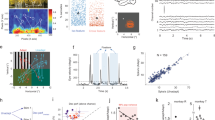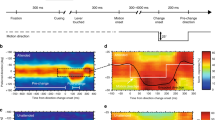Abstract
Prolonged exposure to a stimulus, called 'adaptation', reduces cortical responsiveness. Adaptation has been studied extensively in primary visual cortex (V1), where responsivity is usually reduced most when the adapting and test stimuli are well matched. Theories about the functional benefits of adaptation have relied on this specificity, but the resultant changes in neuronal tuning are of the wrong type to account for well-documented perceptual aftereffects. Here we have used moving sinusoidal gratings to study the effect of adaptation on the direction tuning of neurons in area MT in macaques. Responsivity in MT is maintained best in the adapted direction and is strongly reduced for nearby directions. Consequently, adaptation in the preferred direction reduces the direction-tuning bandwidth, whereas adaptation at near-preferred directions causes tuning to shift toward the adapted direction. This previously unknown effect of adaptation is consistent with perceptual aftereffects and indicates that different cortical regions may adjust to constant sensory input in distinct ways.
This is a preview of subscription content, access via your institution
Access options
Subscribe to this journal
Receive 12 print issues and online access
$209.00 per year
only $17.42 per issue
Buy this article
- Purchase on Springer Link
- Instant access to full article PDF
Prices may be subject to local taxes which are calculated during checkout








Similar content being viewed by others
References
Gibson, J.J. & Radner, M. Adaptation, aftereffect, and contrast in the perception of tilted lines. I. Quantitative results. J. Exp. Psychol. 20, 453–467 (1937).
Clifford, C.W. Perceptual adaptation: motion parallels orientation. Trends Cogn. Sci. 6, 136–143 (2002).
Gibson, J.J. Adaptation, after-effect and contrast in the perception of curved lines. J. Exp. Psychol. 16, 1–31 (1933).
Kohler, W. & Wallach, H. Figural after-effects. Proc. Am. Phil. Soc. 88, 269–357 (1944).
Blakemore, C., Nachmias, J. & Sutton, P. The perceived spatial frequency shift: evidence for frequency-selective neurones in the human brain. J. Physiol. (Lond.) 210, 727–750 (1970).
Levinson, E. & Sekuler, R. Adaptation alters perceived direction of motion. Vision Res. 16, 779–781 (1976).
Patterson, R. & Becker, S. Direction-selective adaptation and simultaneous contrast induced by stereoscopic (cyclopean) motion. Vision Res. 36, 1773–1781 (1996).
Schrater, P.R. & Simoncelli, E.P. Local velocity representation: evidence from motion adaptation. Vision Res. 38, 3899–3912 (1998).
Movshon, J.A. & Lennie, P. Pattern-selective adaptation in visual cortical neurones. Nature 278, 850–852 (1979).
Saul, A.B. & Cynader, M.S. Adaptation in single units in visual cortex: the tuning of aftereffects in the spatial domain. Vis. Neurosci. 2, 593–607 (1989).
Saul, A.B. & Cynader, M.S. Adaptation in single units in visual cortex: the tuning of aftereffects in the temporal domain. Vis. Neurosci. 2, 609–620 (1989).
Muller, J.R., Metha, A.B., Krauskopf, J. & Lennie, P. Rapid adaptation in visual cortex to the structure of images. Science 285, 1405–1408 (1999).
Dragoi, V., Sharma, J. & Sur, M. Adaptation-induced plasticity of orientation tuning in adult visual cortex. Neuron 28, 287–298 (2000).
Dragoi, V., Sharma, J., Miller, E.K. & Sur, M. Dynamics of neuronal sensitivity in visual cortex and local feature discrimination. Nat. Neurosci. 5, 883–891 (2002).
Felsen, G. et al. Dynamic modification of cortical orientation tuning mediated by recurrent connections. Neuron 36, 945–954 (2002).
Dragoi, V., Rivadulla, C. & Sur, M. Foci of orientation plasticity in visual cortex. Nature 411, 80–86 (2001).
Gilbert, C.D. & Wiesel, T.N. The influence of contextual stimuli on the orientation selectivity of cells in primary visual cortex of the cat. Vision Res. 30, 1689–1701 (1990).
Fu, Y.X. et al. Temporal specificity in the cortical plasticity of visual space representation. Science 296, 1999–2003 (2002).
Sur, M., Schummers, J. & Dragoi, V. Cortical plasticity: time for a change. Curr. Biol. 12, R168–170 (2002).
Wainwright, M.J. Visual adaptation as optimal information transmission. Vision Res. 39, 3960–3974 (1999).
Wainwright, M.J., Schwartz, O. & Simoncelli, E.P. Natural image statistics and divisive normalization: modeling nonlinearity and adaptation in cortical neurons. In Probabilistic Models of the Brain: Perception and Neural Function (eds. Rao, R., Olshausen, B.A. & Lewicki, M.S.) 203–222 (MIT Press, Cambridge, 2002).
Barlow, H.B. A theory about the functional role and synaptic mechanisms of visual after-effects. In Vision: Coding and Efficiency (ed. Blakemore, C.) 363–375 (Cambridge Univ. Press, New York, 1990).
Barlow, H.B. & Foldiak, P. Adaptation and decorrelation in the cortex. In The Computing Neuron (eds. Durbin, R., Miall, C. & Mitchinson, G.) 54–72 (Addison-Wesley, New York, 1989).
Zeki, S.M. Functional organization of a visual area in the posterior bank of the superior temporal sulcus of the rhesus monkey. J. Physiol. (Lond.) 236, 549–573 (1974).
Maunsell, J.H. & Van Essen, D.C. Functional properties of neurons in middle temporal visual area of the macaque monkey. I. Selectivity for stimulus direction, speed, and orientation. J. Neurophysiol. 49, 1127–1147 (1983).
Newsome, W.T., Britten, K.H. & Movshon, J.A. Neuronal correlates of a perceptual decision. Nature 341, 52–54 (1989).
Salzman, C.D., Murasugi, C.M., Britten, K.H. & Newsome, W.T. Microstimulation in visual area MT: effects on direction discrimination performance. J. Neurosci. 12, 2331–2355 (1992).
Thiele, A., Dobkins, K.R. & Albright, T.D. Neural correlates of contrast detection at threshold. Neuron 26, 715–724 (2000).
Kohn, A. & Movshon, J.A. Neuronal adaptation to visual motion in area MT of the macaque. Neuron 39, 681–691 (2003).
Leventhal, A.G., Thompson, K.G., Liu, D., Zhou, Y. & Ault, S.J. Concomitant sensitivity to orientation, direction, and color of cells in layers 2, 3, and 4 of monkey striate cortex. J. Neurosci. 15, 1808–1818 (1995).
Snowden, R.J., Treue, S., Erickson, R.G. & Andersen, R.A. The response of area MT and V1 neurons to transparent motion. J. Neurosci. 11, 2768–2785 (1991).
Qian, N. & Andersen, R.A. Transparent motion perception as detection of unbalanced motion signals. II. Physiology. J. Neurosci. 14, 7367–7380 (1994).
Petersen, S.E., Baker, J.F. & Allman, J.M. Direction-specific adaptation in area MT of the owl monkey. Brain Res. 346, 146–150 (1985).
Movshon, J.A. & Newsome, W.T. Visual response properties of striate cortical neurons projecting to area MT in macaque monkeys. J. Neurosci. 16, 7733–7741 (1996).
Albrecht, D.G., Farrar, S.B. & Hamilton, D.B. Spatial contrast adaptation characteristics of neurones recorded in the cat's visual cortex. J. Physiol. (Lond.) 347, 713–739 (1984).
Ohzawa, I., Sclar, G. & Freeman, R.D. Contrast gain control in the cat's visual system. J. Neurophysiol. 54, 651–667 (1985).
Maunsell, J.H. & Van Essen, D.C. The connections of the middle temporal visual area (MT) and their relationship to a cortical hierarchy in the macaque monkey. J. Neurosci. 3, 2563–2586 (1983).
Carandini, M. & Ferster, D. A tonic hyperpolarization underlying contrast adaptation in cat visual cortex. Science 276, 949–952 (1997).
Sanchez-Vives, M.V., Nowak, L.G. & McCormick, D.A. Membrane mechanisms underlying contrast adaptation in cat area 17 in vivo. J. Neurosci. 20, 4267–4285 (2000).
Teich, A.F. & Qian, N. Learning and adaptation in a recurrent model of V1 orientation selectivity. J. Neurophysiol. 89, 2086–2100 (2003).
Thomson, A.M. & Deuchars, J. Synaptic interactions in neocortical local circuits: dual intracellular recordings in vitro. Cereb. Cortex 7, 510–522 (1997).
Movshon, J.A., Adelson, E.H., Gizzi, M.S. & Newsome W.T. The analysis of moving visual patterns. In Pattern Recognition Mechanisms (eds. Chagas, C., Gattass, R. & Gross, C.) 117–151 (Vatican Press, Rome, 1985).
Stoner, G.R. & Albright, T.D. Neural correlates of perceptual motion coherence. Nature 358, 412–414 (1992).
Van Wezel, R.J. & Britten, K.H. Motion adaptation in area MT. J. Neurophysiol. 88, 3469–3476 (2002).
Chaudhuri, A. Modulation of the motion aftereffect by selective attention. Nature 344, 60–62 (1990).
Lehmkuhle, S.W. & Fox, R. Effect of binocular rivalry suppression on the motion aftereffect. Vision Res. 15, 855–859 (1975).
Wiesenfelder, H. & Blake, R. The neural site of binocular rivalry relative to the analysis of motion in the human visual system. J. Neurosci. 10, 3880–3888 (1990).
Chance, F.S., Nelson, S.B. & Abbott, L.F. Synaptic depression and the temporal response characteristics of V1 cells. J. Neurosci. 18, 4785–4799 (1998).
Cavanaugh, J.R., Bair, W. & Movshon, J.A. Nature and interaction of signals from the receptive field center and surround in macaque V1 neurons. J. Neurophysiol. 88, 2530–2546 (2002).
Chandler, J.P. Subroutine STEPIT: finds local minima of a smooth function of several parameters. Behav. Sci. 14, 81–82 (1969).
Acknowledgements
We thank W. Bair, S. Solomon, E. Simoncelli and N. Rust for comments on the manuscript; M. Smith and N. Majaj for assistance with data collection; and M. Hou and N. Doron for histology. This work was supported by a grant from the National Institutes of Health (EY02017) and by an Howard Hughes Medical Institute Investigatorship to J.A.M.
Author information
Authors and Affiliations
Corresponding author
Ethics declarations
Competing interests
The authors declare no competing financial interests.
Supplementary information
Supplementary Figure 1
Predicted shifts in perceived direction for a range of changes in neuronal tuning. (PDF 260 kb)
Rights and permissions
About this article
Cite this article
Kohn, A., Movshon, J. Adaptation changes the direction tuning of macaque MT neurons. Nat Neurosci 7, 764–772 (2004). https://doi.org/10.1038/nn1267
Received:
Accepted:
Published:
Issue Date:
DOI: https://doi.org/10.1038/nn1267
This article is cited by
-
Feedforward attentional selection in sensory cortex
Nature Communications (2023)
-
Unsupervised approach to decomposing neural tuning variability
Nature Communications (2023)
-
Adaptive coding across visual features during free-viewing and fixation conditions
Nature Communications (2023)
-
Attention to visual motion suppresses neuronal and behavioral sensitivity in nearby feature space
BMC Biology (2022)
-
Attractive and repulsive effects of sensory history concurrently shape visual perception
BMC Biology (2022)



